How do you draw a circle? We analyzed 100,000 drawings to show how culture shapes our instincts
Let’s do a quick exercise. Are you ready? Draw a circle in the box below. Don’t think too hard!
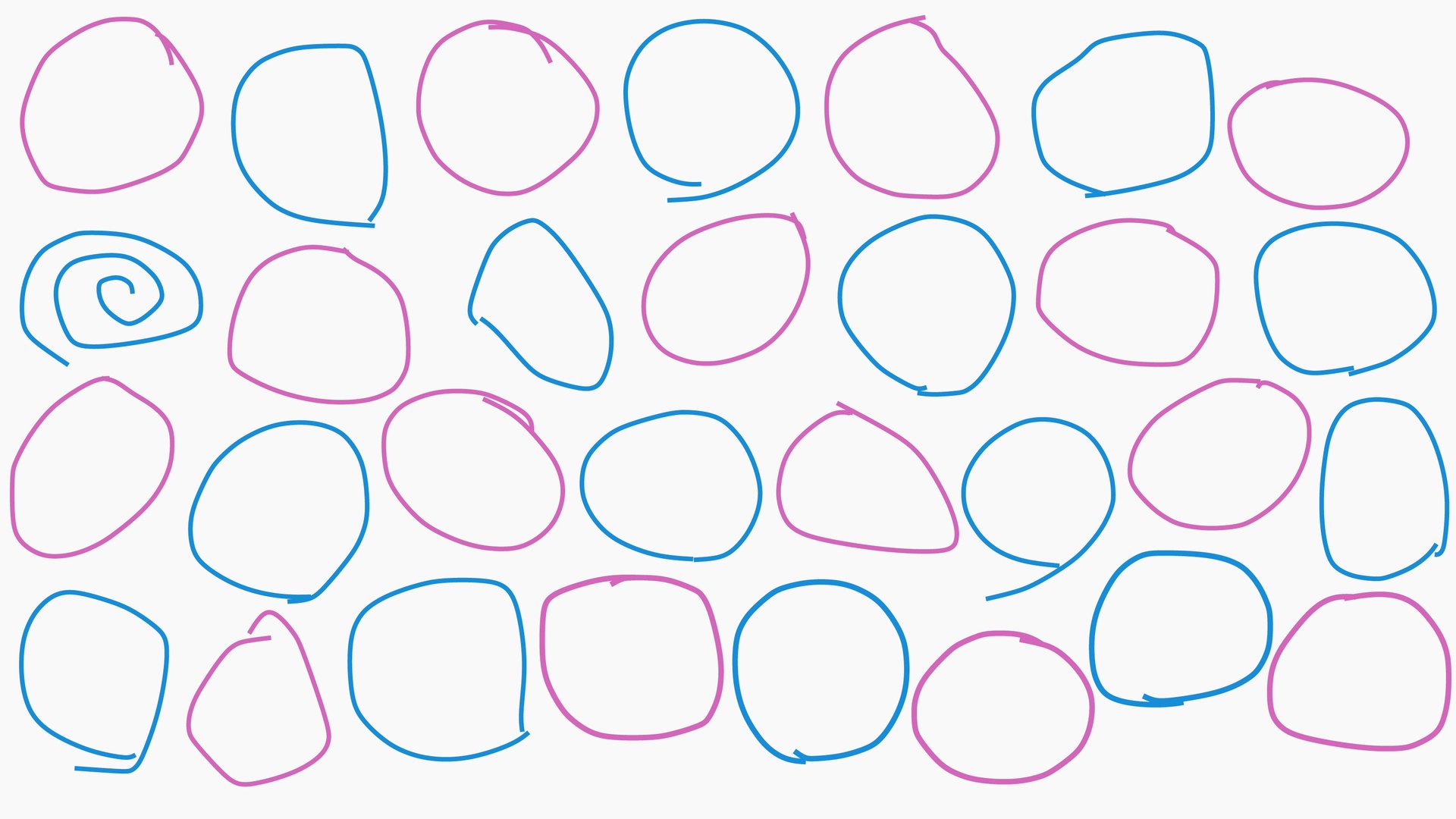

Let’s do a quick exercise. Are you ready? Draw a circle in the box below. Don’t think too hard!
Did you start at the top or bottom? Clockwise or counterclockwise? New data show that the way you draw a circle holds clues about where you come from.
In November, Google released an online game called Quick, Draw!, in which users have 20 seconds to draw prompts like “camel” and “washing machine.” It’s fun, but the game’s real aim is to use those sketches to teach algorithms how humans draw. By May this year, the game had collected 50 million unique drawings.
We used the public database from Quick, Draw! to compare how people draw basic shapes around the world. Our analysis suggests that the way you draw a simple circle is linked to geography and cultural upbringing, deep-rooted in hundreds of years of written language, and significant in developmental psychology and trends in education today.
Circles, a universal form
Revered by the ancient Greeks, essential to Islamic art, and venerated in Zen and Tibetan Buddhism, circles are a universal shape. No matter where you begin, there are really only two ways to draw a circle, a single stroke heading clockwise, or a single stroke heading counterclockwise.
Google’s dataset contains 119,000 unique circles drawn by people in 148 countries, and includes coordinates for the path traced by each player’s finger (or mouse). Applying some simple geometry to data from the 66 countries that submitted over 100 circles, we identified the circle-drawing directions favored by different nations.
Americans tend to draw circles counterclockwise. Of nearly 50,000 circles drawn in the US, 86% were drawn this way. People in Japan, on the other hand, tend to draw circles in the opposite direction. Of 800 circles drawn in Japan, 80% went clockwise. Here’s a random sample of 100 circles people drew in each country:
British, Czech, Australian, and Finnish circles were drawn in the same direction, with the same consistency, as American ones. Some countries are even more regular—around 90% of French, German, and Filipino drawers submitted circles drawn counterclockwise. In Vietnam, a full 95% were drawn this way.
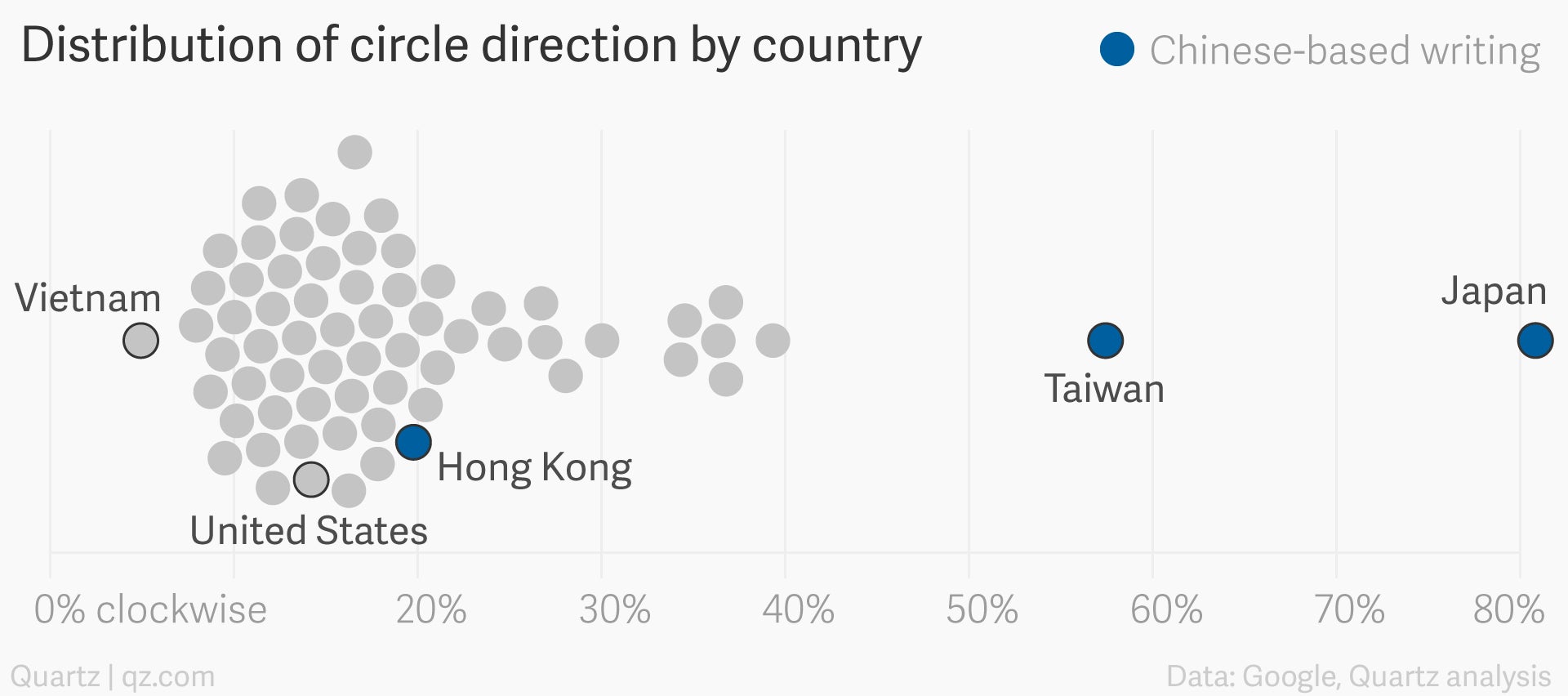
Most of the world, it seems, draws circles counterclockwise, with just two exceptions from our dataset: Taiwan and Japan.
A language for drawing
What could account for the difference? One thing that sets countries apart, of course, is their languages. Could the way people write—top to bottom, left to right, or right to left—explain why they draw abstract shapes differently? Americans, Western Europeans, and Latin Americans of course vary widely in their spoken languages, but share similar scripts. Scripts from Asia and the Middle East, meanwhile, have very different sets of rules for how they’re written.
Here’s how a few representative language groups stacked up:
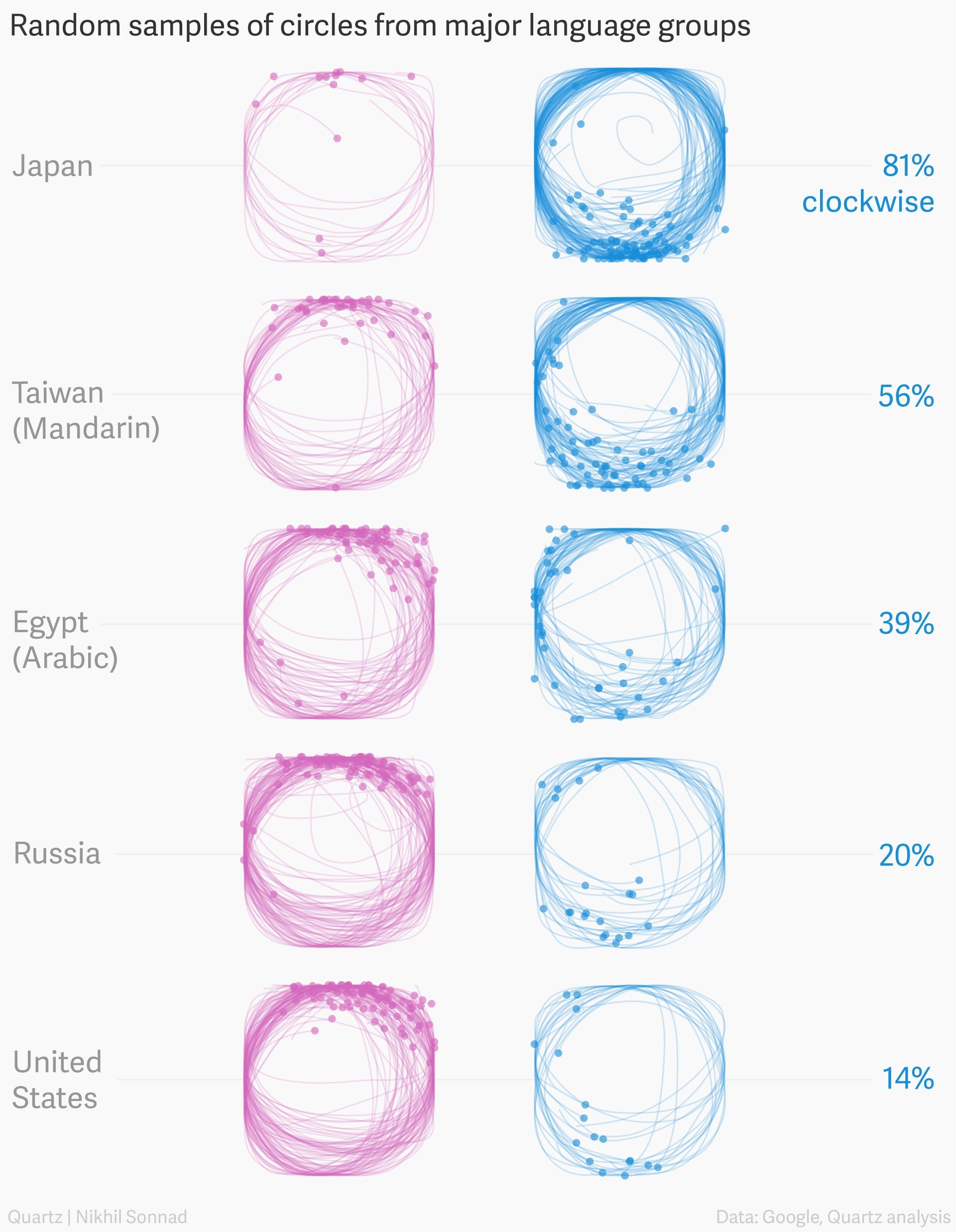
Scripts based on Chinese
Let’s start with Japanese. There are three types of writing used in Japanese: hiragana, katakana, and kanji. Kanji is based closely on the ideogrammatic Chinese character system, while hiragana and katakana are phonetic. Hiragana, the closest to the English alphabet, has the most circular strokes, and most of its curvy characters are drawn with the curve going clockwise:
The character あ, a letter like “a,” is written:
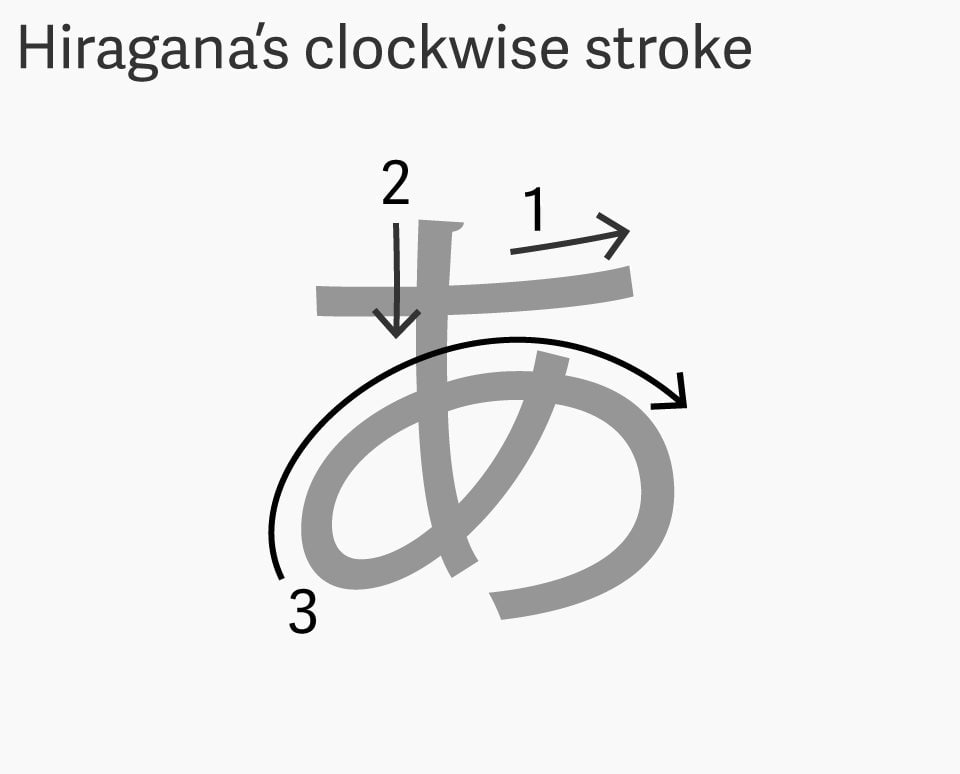
Both Japanese and Chinese scripts follow a strict stroke order. On the whole, characters are drawn from top left in the direction of the bottom right. If you draw a horizontal line and then a vertical line, like in a “7,” the rule is to treat these two lines as one stroke, and to complete the stroke without stopping, says calligrapher and Rutgers mathematics professor Yi-Zhi Huang. So the hand might have a more natural tendency to move in a clockwise direction, like in “了,” which signifies the completion of an action.
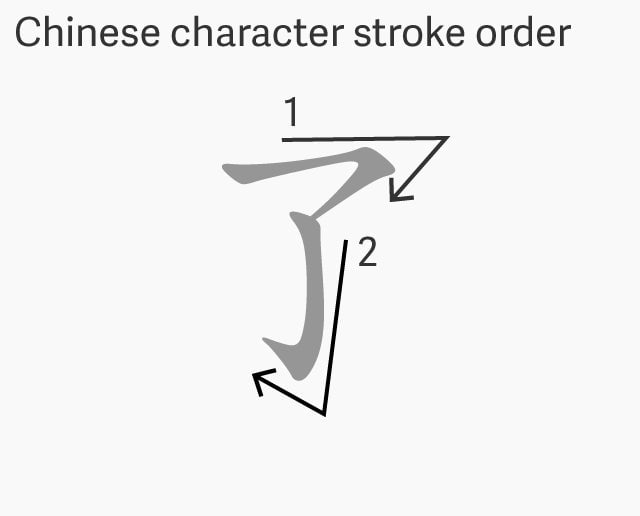
In written languages based on Chinese, these rules are drilled into pupils’ heads from the moment they pick up a pencil, making a strong case for the possibility that people in Taiwan and Japan draw circles based on their shared system of writing. Though there’s no data from China itself, given the country’s Google ban, there is some previous research to support this. A 1985 study of Chinese circle-drawing found that 72% of 151 participants drew their circles clockwise, perhaps because of the clockwise strokes in semi-cursive Chinese calligraphy, wrote the researchers.
The similarity between Chinese-based languages is even stronger if we look at another mighty childhood shape, the triangle. A full 97% of Taiwanese triangles and 90% of Japanese and Korean triangles drawn with one stroke were drawn counterclockwise. By comparison, triangles in the US, when drawn with one stroke, were counterclockwise a little more than half the time.
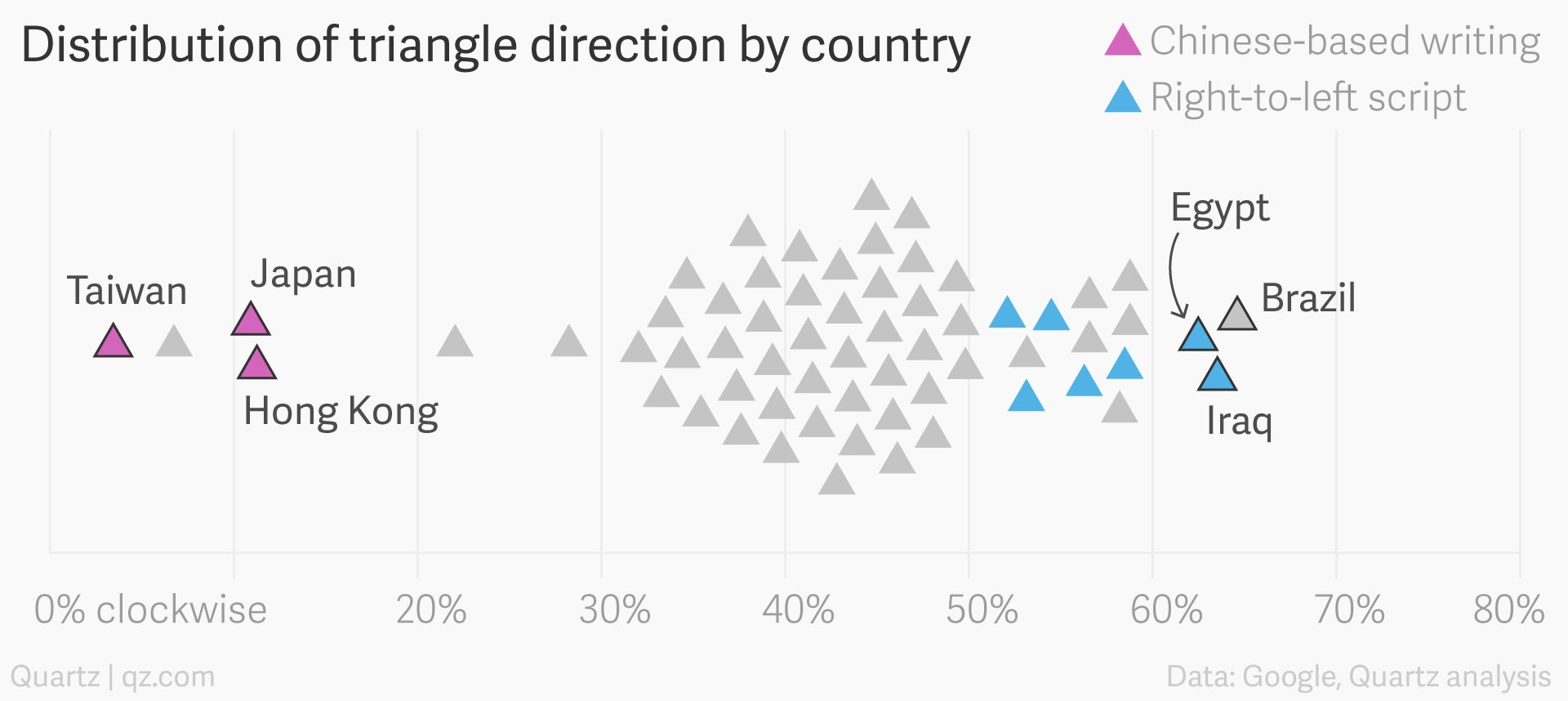
The stroke order in Chinese-based systems dictates that diagonals, like that of a triangle, be drawn right-to-left before left-to-right. This is obvious from the common character 人, meaning “person.”
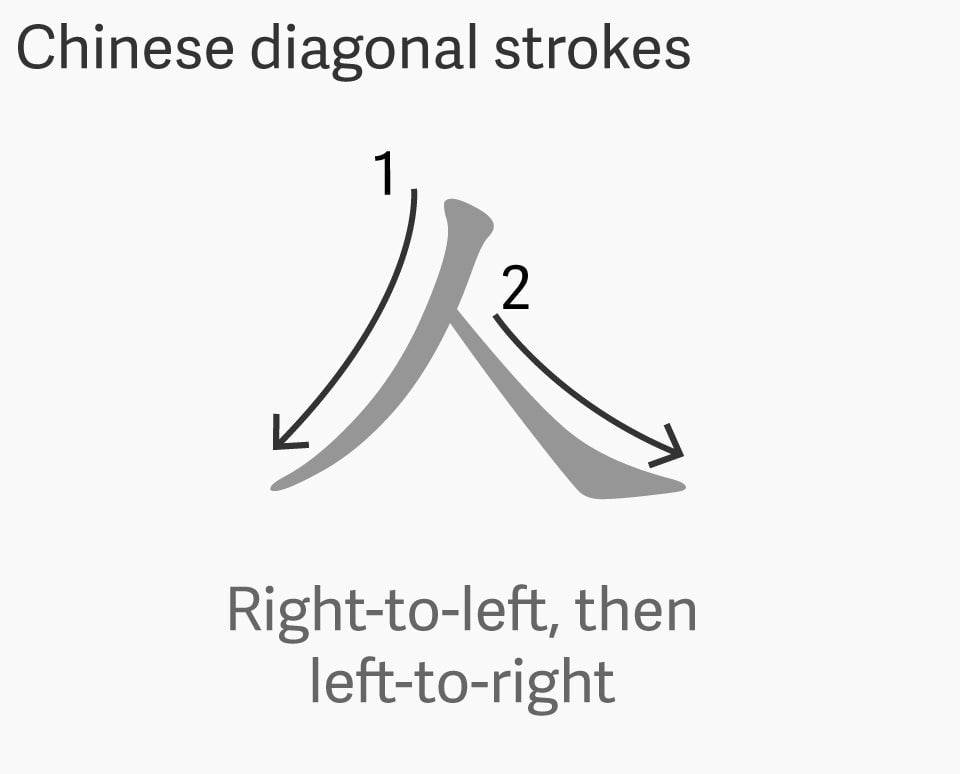
Right-to-left scripts
There’s another major cluster of countries that could help us understand differences in circle-drawing. The United Arab Emirates, Kuwait, Algeria, Jordan, Saudi Arabia, Israel, Iraq, and Egypt huddle together on our plot below, falling neatly side by side (with Thailand and Korea in between).
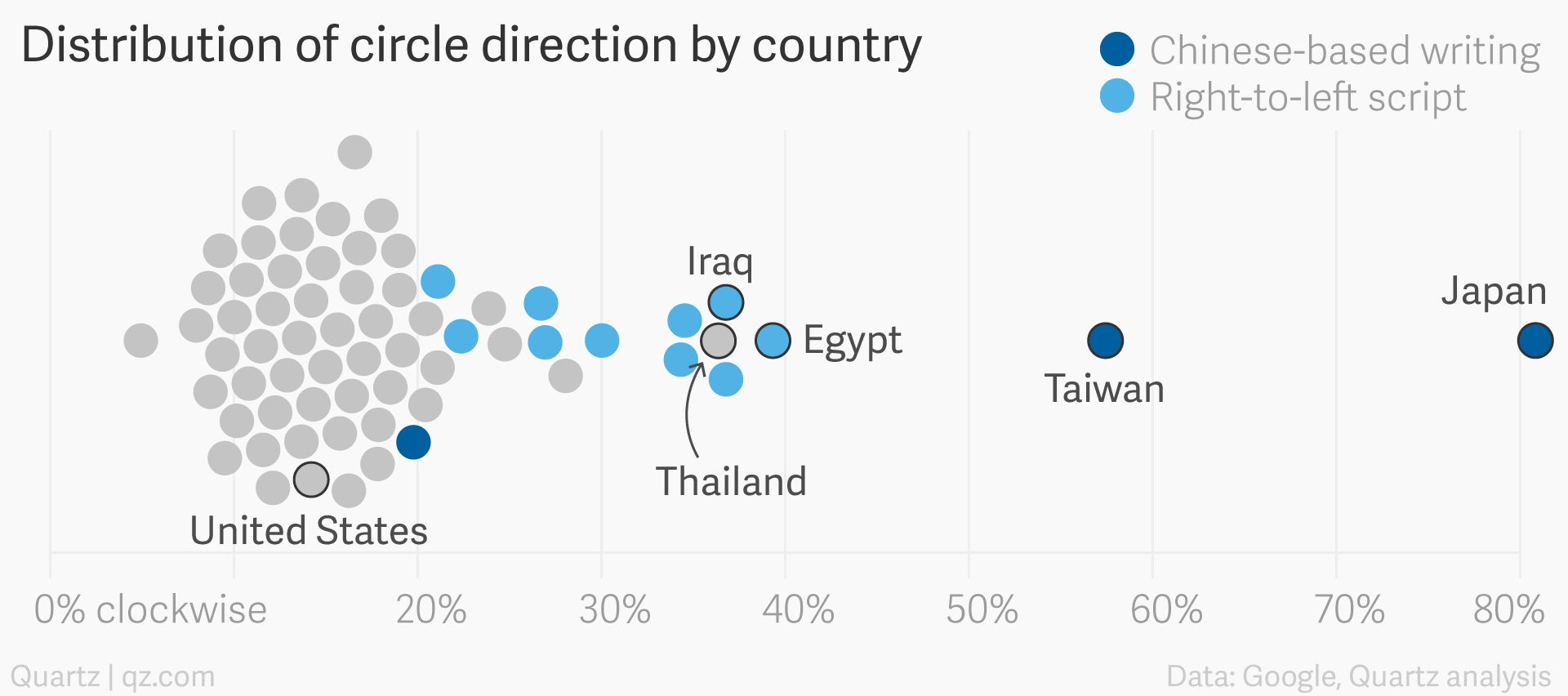
Arabic contains quite a number of curves, and along with Hebrew, is read and written right to left. In Arabic, curves in letters tend clockwise, following the direction of the hand, and help connecting each letter to the next. Here’s the letters “b” and “n”:

Scripts with circles
If we look more closely at circle-drawing across the rest of the world, we can also identify other patterns. Korea’s Hangul writing system, for example, is full of circles. Of the 1,500 circles collected there, 72% were drawn counterclockwise. You might expect South Korea to fall closer on the spectrum to Taiwan and Japan. But as a rule, circles in Hangul go counterclockwise, the opposite direction of the curves in Chinese or Japan. Likely as a result, South Korea is closer to the rest of the world on this crucial issue.
Or consider Thailand, where 64% went counterclockwise, and whose script is full of circles. Of the 42 consonants, nearly all are written starting with a “head,” a tiny loop. The heads can go clockwise or counterclockwise, but there are about twice as many clockwise. Here’s the letter for the sound “m”:
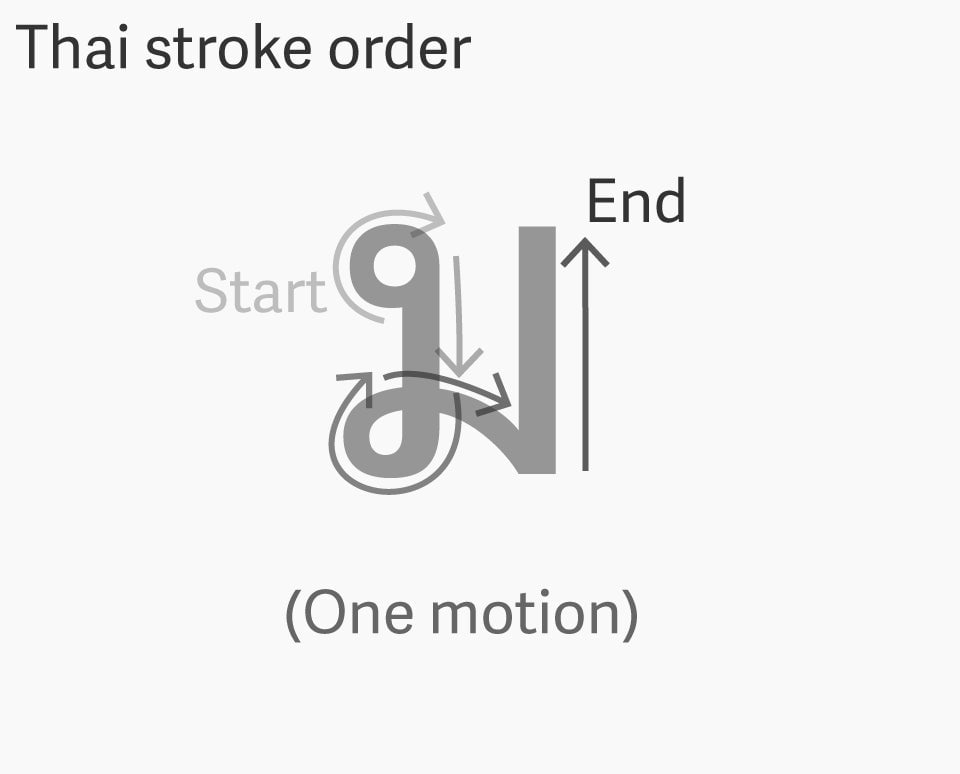
(What about Burmese, or Georgian, two other alphabets chock-full of circles, you might say? With a mere 22% of its circles counterclockwise, Burma is similar to Japan and Taiwan. It’s very tempting to look here to support our theory, but the sample size from Burma is only nine circles. Similarly, Georgia reported only 72 circles, so we must refrain.)
The counterclockwise majority
The remaining 50 odd countries tend to draw their circles counterclockwise. Nearly all of these use the Latin alphabet, which runs left-to-right and is not especially circular. English has a stroke order, too, though it’s far less rigid: Perhaps it’s writing counterclockwise “c” and “g” over and over as kids that has most of the Latin-alphabet world drawing circles that way.
Of course, while there’s a lot of evidence that written languages could influence the way people draw shapes, this theory does not account for everything. Vietnam uses a Latin alphabet like the US and drew 95% of circles counterclockwise, while Hong Kong, which uses a Chinese-based script, drew a hefty 82% counterclockwise circles.
Another potential explanation lies in hand dominance. Perhaps it’s that right-handed people naturally tend toward counterclockwise circles, unless their writing systems teach them otherwise. The data from Quick, Draw! doesn’t show whether users were right or left-handed, which could strongly affect the directions they drew in. Still, hand dominance doesn’t differ greatly from one country to the next, and likely wouldn’t account for the large disparity between Taiwan and Japan, and the rest of the world.
What is normal, anyway?
In a once common psychology exercise for kids called the ”torque test,” developed in 1970s US, children would be given a piece of paper with this on it:
X X X
To help researchers figure out if a child was right or left-handed, the child would be told to draw circles around each X, then again with the other hand. If she drew all the circles counterclockwise (considered evidence of right-handedness) she was said to have “no torque.” If she drew even one circle clockwise (linked with left-handedness), she “had torque.”
In a 1977 paper Theodore Blau, then-president of the American Psychological Association and creator of the torque test, argued that drawing clockwise circles was a sign of learning and behavioral aberrance. Children who drew with torque, he warned, might be at risk of schizophrenia.
Psychologists later refuted that, and a few focused specifically on the effect that culture and education had on children’s shape-drawing habits. One 1997 cross-cultural study looked at American students in the US, Japanese students in Japan, and Japanese students living in the US, at different ages: About half of the study’s 62 Japanese first-graders drew clockwise, a third drew counterclockwise, and a fifth mixed both. But nearly all sixth-graders drew their circles clockwise, which suggested to the researchers that as those children got more exposure to writing, their drawing direction grew more pronounced. In contrast, 64% of American children drew counterclockwise, a percentage that changed only slightly by sixth grade.
But it’s not just Japan. A 1973 cross-cultural study looked at how US and Israeli children copied shapes at different ages and found, too, that American children overwhelmingly drew circles counterclockwise. The reverse was true in Israel, where the closest letter to a circle, ס, is drawn clockwise, noted the researchers. Americans got more consistent in their drawing direction over time, with 100% of adult participants drawing counterclockwise circles. In Israel, 70% of participants drew circles the other way, across ages.
Together these studies show not only that culture and handwriting shape the way people draws abstract shapes; they also suggest our tendencies get stronger over time. The more we write, the more our habits become ingrained.
Now with 90,000 circles collected from across the world for the same purpose, we have a far bigger and more consistent dataset that could back up what these studies have each shown on a small scale.
The rules that inform habit
If English was your first language, you might have forgotten your early school days, spent precariously gripping a pencil and awkwardly forming huge upper and lower case letters in the recommended formation. In some languages, these rules aren’t bygone memories, but paramount for writing.
In Japanese and Chinese, for example, stroke order is an essential component of writing legibly, and can even signal education level.
The modern Chinese stroke order system evolved from clerical script, a system prevalent in the Han dynasty. It simply took too long to write, so as people tried to move faster, the system evolved into clerical running script, a semi-cursive style, and eventually evolving into today’s script. According to Huang, the calligrapher, the use of soft brushes to write could have informed some of the contemporary stroke rules.
Japanese draws on the same stroke order guidelines as Chinese. In 1958 the Japanese Ministry of Education set out the country’s rules for stroke order, to create a consistent system that avoids confusion. (Today the rules have been relaxed.)
“The way I move the brush or pen, it is very efficient, I think, and it’s also pretty,” says Tomoyo Kamimura, director of the language center at the Japan Society. “Some adults write in a completely wrong stroke order, but we despise that,” says Kamimura. “We consider those people as uneducated.”
Today, American kids are increasingly being taught a method of print and cursive called Handwriting without Tears. It promotes the “magic c” (pdf), a counterclockwise curve used in the letters c, g, q, o, among others. A US school, therefore, might promote counterclockwise circles with younger children, to help form the underlying motor skills they’ll need to later write their first letters.
There’s clearly much more to the simple act of drawing shapes than any of us might imagine. A gesture that American psychologists once assumed was natural and right, it turns out, might look odd, even crass, to a native Japanese speaker.
The shape of who we are
There are countless ways that we subtly, unconsciously carry our cultures with us: the way we draw, count on our fingers, and imitate real-world sounds, to name a few. That’s the delight at the heart of this massive dataset. To test our theories, we approached colleagues, friends, and family who write in Japanese, Arabic, Hebrew, Chinese, Thai, and Vietnamese, and, feeling a bit silly, asked them to draw circles. They gladly jumped in, wondering what their fingers would do, and eager to feel part of something larger.
But there’s still plenty we don’t know. Interest in shape-drawing seems to have gone out of style in psychology. With one exception, all of the research we found on cultural shape-drawing and the torque test was from before 1997. Increasingly, people around the world communicate by typing and tapping, but while the art of handwriting might someday get lost all together, perhaps we’re already forming a whole new crop of keyboard-led cultural differences.